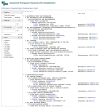KEGG mapping tools for uncovering hidden features in biological data
- PMID: 34423492
- PMCID: PMC8740838
- DOI: 10.1002/pro.4172
KEGG mapping tools for uncovering hidden features in biological data
Abstract
In contrast to artificial intelligence and machine learning approaches, KEGG (https://www.kegg.jp) has relied on human intelligence to develop "models" of biological systems, especially in the form of KEGG pathway maps that are manually created by capturing knowledge from published literature. The KEGG models can then be used in biological big data analysis, for example, for uncovering systemic functions of an organism hidden in its genome sequence through the simple procedure of KEGG mapping. Here we present an updated version of KEGG Mapper, a suite of KEGG mapping tools reported previously (Kanehisa and Sato, Protein Sci 2020; 29:28-35), together with the new versions of the KEGG pathway map viewer and the BRITE hierarchy viewer. Significant enhancements have been made for BRITE mapping, where the mapping result can be examined by manipulation of hierarchical trees, such as pruning and zooming. The tree manipulation feature has also been implemented in the taxonomy mapping tool for linking KO (KEGG Orthology) groups and modules to phenotypes.
Keywords: BRITE hierarchical classification; KEGG; KEGG mapper; KEGG module; KEGG orthology; KEGG pathway map; genome annotation.
© 2021 The Protein Society.
Conflict of interest statement
The authors declare no conflict of interest.
Figures



References
-
- McDonald AG, Tipton KF. Fifty‐five years of enzyme classification: advances and difficulties. FEBS J. 2014;281:583–592. - PubMed
Publication types
MeSH terms
LinkOut - more resources
Full Text Sources
Research Materials

